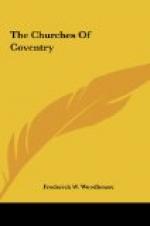There is evident reference to the dedication of the church in the pageant of the “Nine Orders of Angels” shown before Henry VIII and Queen Catherine in 1510.
The history of the church since the Reformation has been not unlike that of a vast number of others. Fanatic destruction, followed by tasteless and incongruous innovations, and these again by “restorations” sometimes as destructive, sometimes as tasteless, and nearly always feeble; such is their common history. In 1569 even the Register books were destroyed because they contained marks of popery, while from 1576 onward a want of repair is plainly suggested by frequent items of expenditure for catching the stares (starlings) in the church, at one time for a net, at another for “a bowe and bolts and lyme.” In 1611 James I addressed a strongly worded letter to the Mayor and Corporation and the Vicar requiring them to reform the practice of receiving the Holy Sacrament standing or sitting instead of kneeling, “As we our Self in our person do carefully perform it.” Whereupon the Bishop wrote that he “felt persuaded that there were not above seven of any note who did not conform themselves” to the church ordinances; while the Vicar said he “did not know of half seven of any note but do the like.”
A Puritanical writer in 1635 thus mentions the changed position of the Communion Table, which had formerly stood away from the east wall: “The Communion Table was altered which cost a great deal of money; and that which is worst of all, three stepps made to go to the Comm’n Table altar fashion—God grant it continueth not long.” Even the font, given by John Cross, mayor, in 1394, had to give place in 1645 to something less offensive to Puritan feeling, and in the same year the brass eagle, given in 1359 by William Botoner, was “sold by order of vestry for 5_d_. the lb., 8_l_. 13_s_. 4_d_.” The rehanging of the bells in 1674 led to the destruction of the beautiful groined vault within the tower, and the year 1764 saw the completion of a series of galleries all round the church. Throughout all this destruction and desecration the citizens happily retained their pride in the great steeple, and by constant attention and rebuildings contrived to preserve it when negligence might have caused its ruin. The scrupulous care given to such work is well shown by items in an account for repairs, of date 1580:
Payed to George Aster for poyntynge ye
steple L7 2 8
Payed for 3 quarter and a halfe of lyme
13 4
Payed for egges
8 4
Payed for glovers pecis, woode & tallowe,
abowte
the lyme
5 6
Payed for a load sand
7-1/2
Payed for 4 stryke of mawlte and gryndyng
7 8-1/2
Payd for 6 gallons of worte more
2 0
Payd for gatherynge of slates & oyster
shelles 3-1/4
Payd to Cookson for the cradle and 3 other
pullesses 5 8




